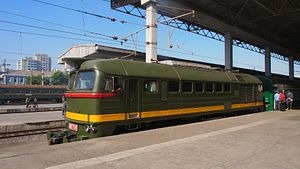Things are changing on the Korean peninsula. On April 27, a historic meeting between the leaders of North and South Korea was held at the South Korean side of the Joint Security Area, near the village of Panmunjom. Although the political (and symbolic) level of the meeting dominated coverage, the Panmunjom Declaration defined various specific points of cooperation between North and South. Among those, the declaration includes a blueprint for building transport connections between North Korea and the world.
Basically, the new declaration repeats projects previously agreed to in October 2007 during the previous inter-Korean summit and released in the 2007 October 4 Declaration. According to the Panmunjom Declaration, “The two sides agreed to adopt practical steps towards the connection and modernization of the railways and roads on the eastern transportation corridor as well as between Seoul and Sinujiu for their utilization.”
During the April summit, South Korea’s President Moon Jae-in reportedly presented a plan to reconstruct three cross-border railways to the North. The plan includes taking practical steps to utilize the west coast Gyeongui railway, east coast Donghae railway, and Gyeongwon line located in the middle of the peninsula.
The 309-mile-long Gyeongui line was a railway line of the Chosen Government Railway (a state-owned railway company in Korea under Japanese rule) running from Seoul to the city of Sinuiju, located on the border between North Korea and China. The standard gauge (1,435 mm) railway connected the Korean railway system to the rest of Asia and even Europe. The current idea is to repeat history by using this line to connect South Korea with the Chinese railway network.
After the partition of Korea in 1945, the Gyeongui line was divided between North and South Korea. After the Korean War armistice was signed in 1953, southern train service ran between Seoul and Munsan only and the northern branch terminated at Kaesong. North Korea renamed the southern Pyongyang-Kaesong section of the line the Pyongbu line and the northern Pyongyang-Sinuiju section the Pyongui line. The North Korea part of the Gyeongui line is fully electrified, although the double track section spans only from Pyongyang to Sunan airport (15.7 miles). The Pyongbu line is the only line in the North where speeds of up to 60 miles/hour are permitted.
Between 2000 and 2004, the Gyeongui line was reconnected through the Demilitarized Zone border area and southern passenger service was extended to Dorasan at the edge of the DMZ. In 2007, North and South Korea agreed to continue the railway reconstruction project: on May 17, 2007 the first train carrying North and South Korean delegations traveled from Munsan Station in the South to Kaesong in the North. Later, however, the agreement to restore the full line lapsed due to political tensions.
The Donghae railway is a railway line on the eastern Korean coast; parts of the line are in use, but some are in the planning phase. The cross-border part of the line. known as the Donghae Bukbu line, was reopened in 2007 to provide access to the Mount Kumgang Tourist Region, then open to South Korean tourists. Operations started on May 17, 2007 and the line carried trains for a brief period during 2007 and 2008. The line continues into the North Korea as the Kumgangsan Chongnyon line, which is electrified.
The Donghae railway will connect the South with North Korea’s third-largest city, Chongjin, and Rajin, which has the highest GDP per capita in North Korea thanks to the Rason industrial zone. It will also link South Korea with Russia and the Trans-Siberian mainline.
The third line possibly scheduled for reopening is the Gyeongwon line located in the middle of the peninsula.
The ambitious plans, which include construction of a high-speed line between Seoul and Pyongyang, are estimated to cost $35 billion.
The final question regarding cross-border railway lines between two Koreas is the most important question for any traffic infrastructure project – and that is how it will be used. The cities of Seoul and Pyongyang will generate significant amounts of passenger traffic if and when the border procedures are relaxed enough for normal travel. The potential for freight is even more interesting — South Korea is certainly very keen to connect their railway system with the systems in China and Russia. Completing these cross-border links with the North means that in the future South Korea will be connected to China’s Belt and Road and the Trans-Siberian railway, enabling rail transportation between South Korea and Europe.
Previous attempts to connect the Korean peninsula to the rail lines heading toward Europe included the opening of the dual track (normal and broad track) line between the Russian border (Tumangang/Khasan) and North Korea’s Rajin (home to Rason Special Economic Zone) on September 22, 2013. The Tumangang/Khasan–Rajin line is operated by RasonKonTrans, a joint venture of RZD subsidiary Russian Railways Trading Company (70 percent) and the Port of Rajin (30 percent). The project was agreed upon by late North Korean leader Kim Jong-Il and Russian President Vladimir Putin in August 2001, as part of the hoped-for reconstruction of the trans-Korean railway. Russia has also built two freight railway corridors, known as Primorye I and Primorye 2, in recent years to allow a connection between the Far Eastern Russian ports and China, bypassing North Korea territory.
The distances involved in these rail projects, both physical and symbolic, are not small. But railways on the Korean peninsula look to have a bright future.
Toma Bačić is a longtime collaborator of the leading international railway and logistics magazine Railway Gazette International, specializing in East Asia, Russia, One Belt One Road, and Eastern European subjects.

































